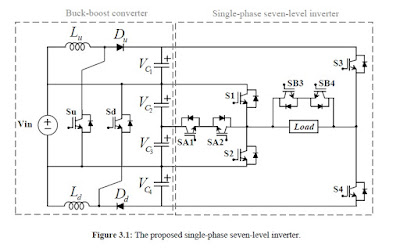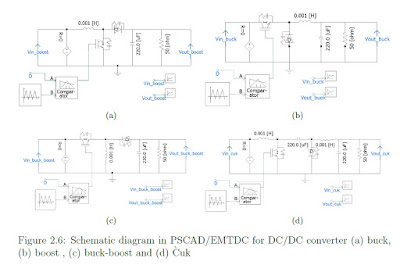domingo, 25 de novembro de 2018
sábado, 24 de novembro de 2018
Master’s Thesis A Study on High Quality Single-Phase Seven-Level Grid-Connected Inverter- Department of Electrical Engineering Graduate School, Chonnam National University-South Korea Le Tuan Vu
A Study on High Quality Single-Phase Seven-Level Grid-Connected Inverter Le Tuan Vu Department of Electrical Engineering Graduate School, Chonnam National University (Supervised by Professor Sung-Jun Park)
(Abstract) Multilevel inverter technology has emerged recently as a very important alternative in the area of high-power medium-voltage energy control. Multilevel inverters include an array of power semiconductors and capacitor voltage sources, the output of which generate voltages with stepped waveforms. The commutation of the switches permits the addition of the capacitor voltages, which reach high voltage at the output, while the power semiconductors must withstand only reduced voltages. There are three commonly topologies have been proposed for multilevel inverters: diode-clamped (neutralclamped); capacitor-clamped (flying capacitors); and cascaded multicell with separate dc sources. The most attractive features of multilevel inverters are that they can generate output voltages with extremely low distortion, they draw input current with very low distortion and they can operate with a lower switching frequency. In this paper, a new type of the multilevel single-phase grid-connected inverter is proposed. Like other multilevel inverters, the proposed inverter has fully all the features of the multilevel inverters but has less number of switches than the ones of three types of commonly multilevel inverter with the same number of levels output voltage. The operational principle and the switching functions are analyzed in this paper. To verify the performance of the proposed inverter, PSIM simulation and experimental results are also shown in this paper.
LINK
http://www.mediafire.com/file/z7ede2f3gm9g07d/Seven-Level_Grid-Connected_Inverter.pdf/file
quarta-feira, 21 de novembro de 2018
ANALYSIS AND SIMULATION OF PHOTOVOLTAIC SYSTEMS INCORPORATING BATTERY ENERGY STORAGE Oluwaseun Akeyo College of Engineering at the University of Kentucky
ANALYSIS AND SIMULATION OF PHOTOVOLTAIC SYSTEMS INCORPORATING BATTERY ENERGY STORAGE Oluwaseun Akeyo College of Engineering at the University of Kentucky
A thesis submitted in partial ful llment of the requirements for the degree of Master of Science in Electrical Engineering in the College of Engineering at the University of Kentucky By Oluwaseun Akeyo Lexington, Kentucky
ABSTRACT OF THESIS ANALYSIS AND SIMULATION OF PHOTOVOLTAIC SYSTEMS INCORPORATING BATTERY ENERGY STORAGE
Solar energy is an abundant renewable source, which is expected to play an increasing role in the grid’s future infrastructure for distributed generation. The research described in the thesis focuses on the analysis of integrating multi-megawatt photovoltaics systems with battery energy storage into the existing grid and on the theory supporting the electrical operation of components and systems. The PV system is divided into several sections, each having its own DC-DC converter for maximum power point tracking and a two-level grid connected inverter with different control strategies. The functions of the battery are explored by connecting it to the system in order to prevent possible voltage fluctuations and as a buffer storage in order to eliminate the power mismatch between PV array generation and load demand. Computer models of the system are developed and implemented using the P SCADTM/EMT DCTM software. KEYWORDS: photovoltaics, battery, energy storage, inverter, solar pump, IEEE 14 bus.
segunda-feira, 12 de novembro de 2018
Seminário Científico de Sistemas de Eletrônica de Potência – SCSEP 2018-11 E 12 DEZEMBRO 2018 Instituto de Eletrônica de Potência (INEP)-FLORIANOPOLIS-UFSC
O Instituto de Eletrônica de Potência (INEP) promoverá o terceiro Seminário Científico de Sistemas de Eletrônica de Potência – SCSEP 2018, evento que ocorrerá nos dias 11 e 12 de dezembro de 2018 no Auditório Luiz Antonio Teixeira, localizado no prédio da Engenharia Elétrica da UFSC, Florianópolis e será organizado por comissão local.
O seminário está programado para receber aproximadamente 100 pessoas, entre alunos e professores da instituição e de outras, assim como profissionais da área que atuam nos setores público e privado. O evento tem como objetivo apresentar e divulgar os últimos avanços da área por meio da ação de alunos e pesquisadores do Instituto, incluindo pós-doutorandos, doutorandos, mestrandos, alunos de iniciação científica e tecnológica e em conclusão de curso de graduação. Tais trabalhos estão sendo desenvolvidos no INEP e se encontram em estágio avançado, representando possíveis soluções para a indústria e possibilitando, assim, a interação entre as partes. No evento serão realizadas também palestras e debates com convidados especialistas da área, com a finalidade de discutir as tendências e demandas atuais para a área de Eletrônica de Potência, bem como suas perspectivas futuras.
LINK ORIGINAL
http://scsep.inep.ufsc.br/
Assinar:
Postagens (Atom)































































 JOSIL ARTISTA PLASTICO FORTALEZA CEARA BRASIL AV.HERACLITO GRAÇA 41 TEL(85)32542378
JOSIL ARTISTA PLASTICO FORTALEZA CEARA BRASIL AV.HERACLITO GRAÇA 41 TEL(85)32542378
















